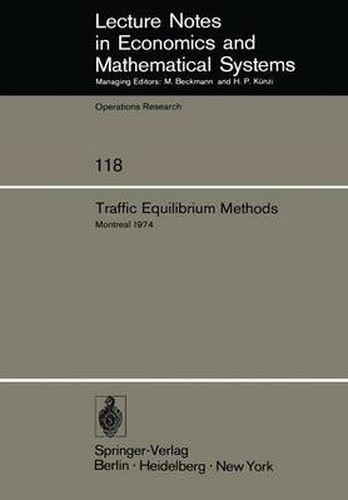Readings Newsletter
Become a Readings Member to make your shopping experience even easier.
Sign in or sign up for free!
You’re not far away from qualifying for FREE standard shipping within Australia
You’ve qualified for FREE standard shipping within Australia
The cart is loading…






This title is printed to order. This book may have been self-published. If so, we cannot guarantee the quality of the content. In the main most books will have gone through the editing process however some may not. We therefore suggest that you be aware of this before ordering this book. If in doubt check either the author or publisher’s details as we are unable to accept any returns unless they are faulty. Please contact us if you have any questions.
The interest in the mathematical modeling of transportation systems stems from the need to predict how people might make use of new or improved transport infrastruc ture in order to evaluate the benefit of the required investments. To this end it is necessary to build models of the demand for transportation and models that de termine the way in which people who travel use the transportation network. If such models may be constructed and their validity reasonably assured, then the predic tion of the traffic flows on future and present transportation links may be carried out by simulating future situations and then evaluating the potential benefits of alternative improvement projects. In the attempts that were made to construct mathematical models of transportation networks, the notion of equilibrium plays a central role. Suppose that the demand for transportation, that is, the number of trips that occur between the - rious origins and destinations is known. Then it is necessary to determine how these trips are attracted to the alternative routes available between origins and destinations. Knight (1924), gave a simple and intuitively clear description of the behaviour of road traffic under conditions of congestion.
$9.00 standard shipping within Australia
FREE standard shipping within Australia for orders over $100.00
Express & International shipping calculated at checkout
This title is printed to order. This book may have been self-published. If so, we cannot guarantee the quality of the content. In the main most books will have gone through the editing process however some may not. We therefore suggest that you be aware of this before ordering this book. If in doubt check either the author or publisher’s details as we are unable to accept any returns unless they are faulty. Please contact us if you have any questions.
The interest in the mathematical modeling of transportation systems stems from the need to predict how people might make use of new or improved transport infrastruc ture in order to evaluate the benefit of the required investments. To this end it is necessary to build models of the demand for transportation and models that de termine the way in which people who travel use the transportation network. If such models may be constructed and their validity reasonably assured, then the predic tion of the traffic flows on future and present transportation links may be carried out by simulating future situations and then evaluating the potential benefits of alternative improvement projects. In the attempts that were made to construct mathematical models of transportation networks, the notion of equilibrium plays a central role. Suppose that the demand for transportation, that is, the number of trips that occur between the - rious origins and destinations is known. Then it is necessary to determine how these trips are attracted to the alternative routes available between origins and destinations. Knight (1924), gave a simple and intuitively clear description of the behaviour of road traffic under conditions of congestion.